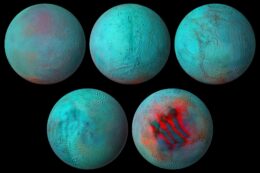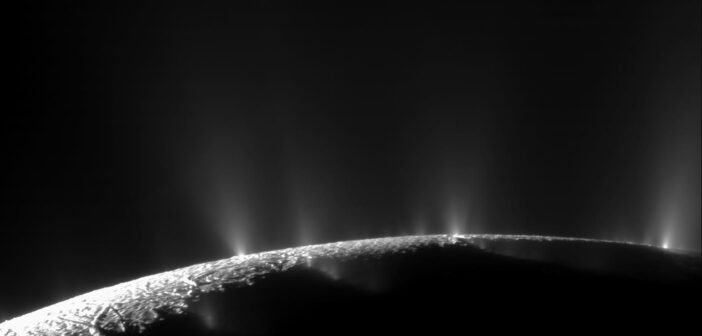Saturn’s moon Enceladus is a promising place to look for life in our solar system. A recent research article introduces the Astrobiology eXploration at Enceladus mission concept, which aims to examine the icy moon’s habitability and geological history.
A Promising Target

Composite optical and infrared images of Enceladus taken at various angles. The “tiger stripes” from which the plumes originate overlap with a warm region at the moon’s south pole. [NASA/JPL-Caltech/University of Arizona/LPG/CNRS/University of Nantes/Space Science Institute]
Further data suggested that Enceladus’s plumes emanate from a global ocean that sloshes beneath the moon’s icy surface, warmed by tidal stresses from Saturn’s gravitational pull. The combination of water, organic molecules, and heat makes Enceladus an enticing target in the search for life beyond Earth. But the Cassini mission is far in our rear-view mirror — where do we go from here?
Mission to an Icy Moon
Long before spacecraft drop into orbit around planets or pass by moons, long before launch or loading or assembly, teams of scientists craft detailed mission plans that outline what the mission will accomplish and how. Today’s research article introduces one such plan developed during a session of the Jet Propulsion Laboratory’s Planetary Science Summer School, which invites teams to put their heads together to devise missions to explore the solar system. (Astrophysicists and solar physicists have their own versions of this program, too!)

Illustration of Enceladus’s plume environment and the specific regions targeted by AXE. Click to enlarge. [Adapted from Seaton et al. 2023]
From Idea to Implementation
AXE has some big goals, like figuring out if there’s life in Enceladus’s subsurface ocean. For a mission proposal to be successful, it has to outline exactly how that mission will achieve its goals. This means laying out the physical quantities the instruments must measure, and how precisely the measurements must be made. It even has to wrestle with possible complications, like instrument degradation or failure.

Demonstration of how the abundance of molecules differs between biotic processes (i.e., life) and abiotic processes. Click to enlarge. [Seaton et al. 2023]
As you can imagine, there’s far more involved in crafting a mission plan than can be included in this short summary — be sure to check out the full article linked below to learn more!
Citation
“Astrobiology eXploration at Enceladus (AXE): A New Frontiers Mission Concept Study,” K. Marshall Seaton et al 2023 Planet. Sci. J. 4 116. doi:10.3847/PSJ/acd119

